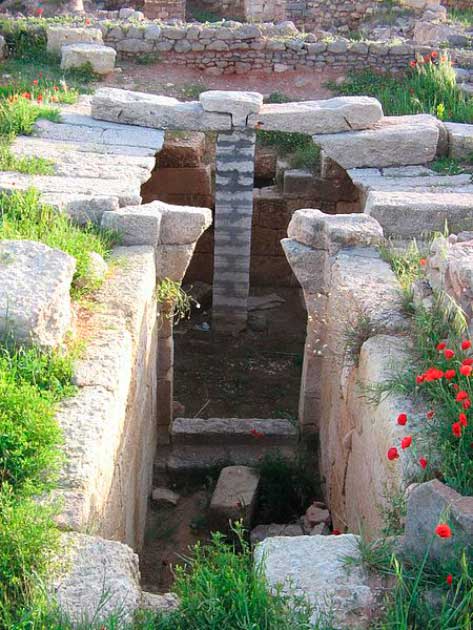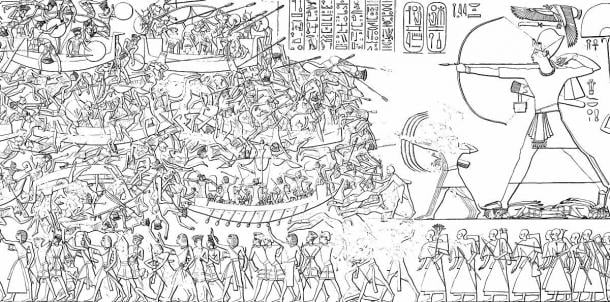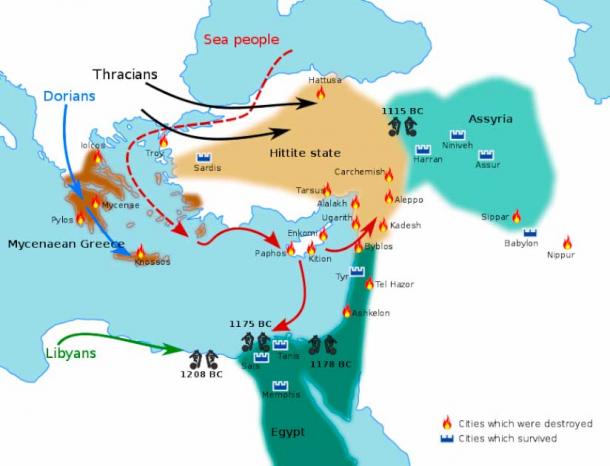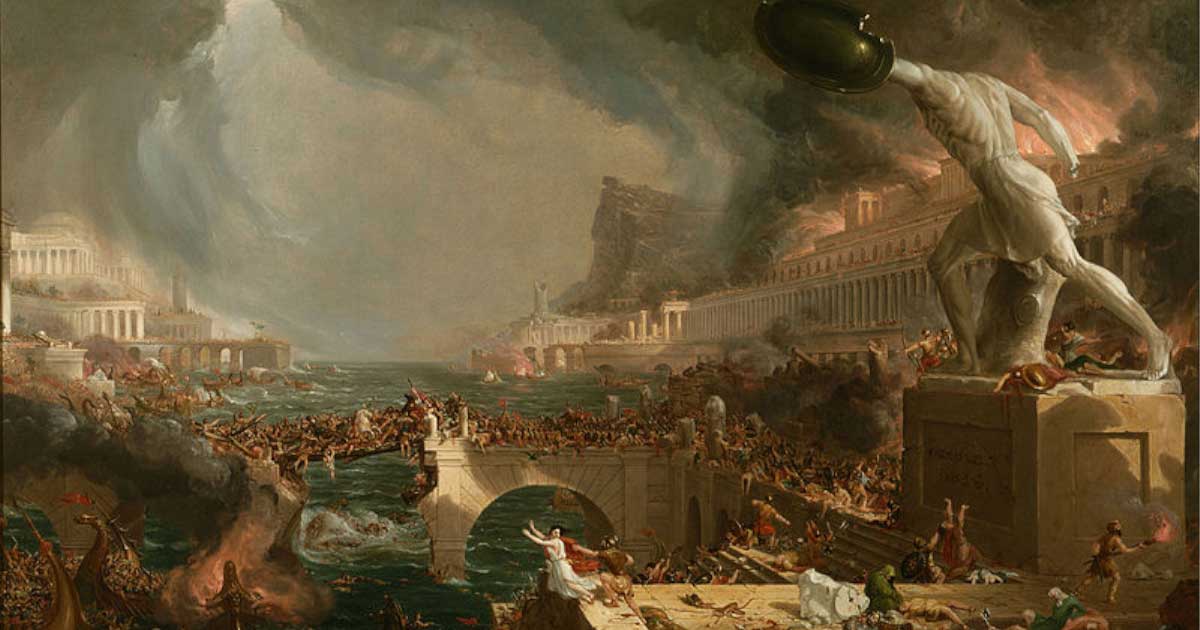Civilization's Midnight: The Late Bronze Age Collapse
To the layman who is educated in the Euro-Centric tradition, history stops at the Greeks. We are all familiar with the militaristic ferocity of the Spartans and the open atmosphere of discourse in Athens. Yet, we know little about what happened before that. For all we know, civilization was in its pre-embryonic stage, and humans lived in tribal societies where might is right and the objective was to survive. This cannot be further from the truth.
A Forgotten Age: The Near East in the Late Bronze Age
A millennium before the emergence of the likes of Plato or Leonidas, the ancient Mediterranean was a bustling, metropolitan ecosystem consisting of varying cultures and societies. Complex alliances not unlike the Balance of Powers in 19th century Europe existed, and cultural interactions reminiscent of 21st century globalization took place. It was a bygone age far ahead of its time.
In the south, the New Kingdom of Egypt dominated the Nile. At that time, around 1500 BC, they had already existed for 2 millennia. In Mesopotamia and Canaan, small city states vied for influence, while the Assyrian Empire loomed as a constant threat in the background. In mainland Greece, the Mycenaean civilization flourished with their naval prowess and penchant for commerce. To their east in Anatolia existed the Hittites, an early group of Indo-Europeans feared for their fighting capabilities and rapid expansion of territory.
- The Bronze Age - A Spark That Changed the World
- Mediterranean Bronze Age Collapse Linked to Deadly Typhoid and Plague
A Mysterious Decline
In the 50 years between 1200-1150 BC, all these civilizations suffered a mysterious decline. A sudden, precipitous drop in activity was experienced. Cities stopped trading with each other, and many literary records were destroyed. Urban centers were abandoned, and there were massive outflows of population. Once formidable cities were torched to ruins, and capitals were razed to the ground. To quote Robert Drews:
"Within a period of forty to fifty years at the end of the thirteenth and the beginning of the twelfth century, almost every significant city in the eastern Mediterranean world was destroyed, many of them never to be occupied again."
It was a calamitous destruction of proportions unseen till the collapse of the Western Roman Empire. A dark age would ensue for more than 400 years, until the Greeks began to colonize and the Assyrians re-established control over the Near East. However, there was little to no inter-regional relationship. Any development was heavily localized, and it seemed that the collapse permanently signaled the end of an era.

Late Bronze Age Sanctuary of Myrtou-Pigadhes, Cyprus. (Yak / CC BY-SA 3.0)
It was, and still is, a profound mystery. Scholars of antiquity struggled to understand the nature and cause of this event. The palatial ruins bespoke of an unspeakable terror, but the lack of evidence precluded any convincing thesis that sufficiently explained the collapse. Recent advances in archaeological technology and the unearthing of primary textual sources have shed light on the issue, but narratives can be drastically different.
For example, some posited that the Hekla 3 volcano eruption in Iceland cooled global temperatures, leading to poor harvests, famines, and societal breakdown as banditry and anarchy reigned. Others argue there were revolutions in warfare that made insurgencies powerful, weakening the state's military capabilities. However, none of them seemed to be encompassing enough. While we can say that famine, disease, or more efficient warfare resulted in the collapse, why did it create such a perfect storm?
One can attribute it to luck, but that isn't satisfactory as an explanation and is unlikely as well. Rather, I argue that the factors served to underline existing issues of fragility within the political entities. Volcanic eruptions, drought, and foreign invasions merely expedited an already teetering equilibrium.
Ugarit: New York of the Levant
But it is too early to dive into theories. Let us reconstruct the world of the Late Bronze Age with the very limited evidence we have. Ugarit is a city-state located in Northern Syria. Situated at the crossroads between the Hittite empire in the north and Egypt in the south, it was an international entrepot bustling with trade. Text archives evidenced mercantile transactions of perishable goods such as dyes, bronze, oil, copper, linen, and produce. Specifically, Ugarit exported a lot to Assyria, an increasingly powerful force in the East.
Ugarit imported heavily as well: palatial ruins uncovered Mycenaean pottery, bronze weaponry personally inscribed by the Egyptian pharaoh Merneptah, and Cypriot copper. It was rich and prosperous. Within the thick alabaster warehouses lay urns of precious goods transported by merchants who frequented all four corners of the known world.

A tomb in the royal palace’s courtyard at Ugarit, Syria. (Gianfranco Gazzetti / GAR / CC BY-SA 4.0)
Foreign emissaries—especially those from their overlords, the Hittite Empire—would have also been a common sight. A particular clay tablet talked about a wealthy merchant, Sinaranu: " His [grain], his beer, his (olive)-oil to the palace he shall not deliver. His ship is exempt when it arrives from Crete." Not only was there concrete evidence of regular trade across seas, there also existed the development of commercial ideas such as private property. The economic character of this metropolitan port city endured throughout external hardships.
While the Egyptians and the Hittites fought in the Battle of Kadesh, the largest chariot war of antiquity, business was as usual at Ugarit. Yet, between the 5 years from 1190-1185 BC, everything came crashing down. The city was razed to the ground and reduced to nothing but rubble. Excavations revealed a destructive layer 2 meters (6.56 feet) deep. More than 650 years would pass before it was inhabited ever again.
Naturally, we can only surmise that something terrible happened, but we cannot know what exactly happened with the lack of literary sources. Luckily, there was one enigmatic plea written by then King of Ugarit, Ammurapi, to the King of Cyprus: "My father, now the ships of the enemy have come. They have been setting fire to my city and have done harm to my land." The ruler of Carchemish came to the aid, but found nothing but ruins as they received a private message from the Ugaritites:
"When your messenger arrived, the army was humiliated and the city was sacked. Our food in the threshing floors was burnt and the vineyards were also destroyed. Our city is sacked. May you know it! May you know it!"
It was a foreboding story that was replicated throughout Canaan, from Tell Kazel to Tel Megiddo.
Sea Peoples: The Wild Hunt of the Ancient Mediterranean
The specter of barbaric “sea peoples” who sacked cities ran amok throughout the coastal cities. Since Ramesses II, there were records of seafaring pirates of varying ethnicities pillaging cities along the Nile Delta. Pharaoh Merneptah subjugated the raiders named the "9 bows", a confederation of northern foreigners driven by foreign kings and revolts.
His successor, Ramesses III, experienced the final and most well-documented invasion. He repulsed two waves of large-scale attacks in the Nile Delta and Djahy. Depictions on the relief of the temple at Medinet Habu revealed the enormous scale of the Battle of the Delta: Heaps of Sea Peoples writhing in agony after being shot by the Egyptians, who are purposely inflated in size.

Relief from the mortuary temple of Ramesses III at Medinet Habu, depicting the Battle of the Delta. (Public Domain)
The tenacity of the motley crew was indicative of desperation. They were trying to escape and resettle, not to conquer and expel. Something must have driven them away, but we do not have definitive evidence as to who they were or why they carried out such attacks. Similarly destroyed were the Mycenaean city states and Cyprus. Before their destruction, we find increases in fortifications as well as indications of militarization with archaeological findings of arrow shafts and bronze weapons. Nearing the disaster, these states were embroiled in conflict.
Inland cities weren't saved either. The Hittite Empire in Anatolia suffered the most complete defeat. Plagued by internal rebellions and constant warfare with the Assyrians, the Hittites suffered the last straw with the sacking of their capital, Hattusa, by a conglomerate of individuals from the Black Sea, Greece and Western Anatolia. The Assyrian Empire was not directly affected, but hordes of foreign attacks made them wary of expansion.
After the death of Assyrian King Aššūr-bēl-kala, the state remained confined within its original borders. The lack of commerce and the threat of depopulated brigands weakened the Assyrian state, but its institutional strength helped it weather the crisis exceptionally well.
The crisis was severe and did not seem to be localized. Within a short span of a few decades, a collective tumult destroyed most Near-Eastern civilizations. Its most apparent characteristics were violent barbarian invasions and internal revolt. At the same time, society seemingly collapsed, and the stratum of the social elite vanished as massive depopulation occurred.
- Bronze Age Cataclysmic Comet Responsible For The Sea People
- Climate Change may have Caused Collapse of Civilizations in Late Bronze Age
Acts of God: Drought, Famine, and Environmental Factors
Other underlying factors such as famine and drought have been adduced as well. Rhys Carpenter argued that inclement conditions in Northern Europe drove tribes southwards - who became the Sea Peoples. In the Greek context, he noted how the sudden outflow of Mycenean Greeks was the result of land-hungry Dorians and Thracians taking over their land. Environmental factors such as volcanic eruptions or earthquakes can thus explain the presence of Sea Peoples.
Archaeologically, there was scientific evidence for these phenomena too. Preliminary reports show widespread drought in the Nile, Middle East, and Turkey. The water level of the Dead Sea dropped by 50 meters (164.04 feet) at the end of the second millennium BC, indicating a slow and steady decline in rain and water supply.
Returning to the microcosm of Ugarit, we see large quantities of grain shipment to the Hittites nearing the 13th century. A few years earlier, the Hittite Queen wrote to the Egyptian Pharaoh that: "I have no grain in my lands." A mixture of environmental disasters befell the late Bronze Age.

Smaller tablet of Treaty of Kadesh, discovered at Boğazköy, Turkey. Museum of the Ancient Orient, one of the Istanbul Archaeology Museums. (Iocanus / CC BY 3.0)
A Combination of Factors: A Perfect Storm
Another possibility would be a change in warfare. Until then, wars were fought in chariots. They were the sole dominion of the aristocracy, and heavy ritualistic connotations prevailed throughout the battle. In the Battle of Kadesh, the infantry was auxiliary support instead of the main fighting force. This made units immobile and slow.
The rise of flexible, mobile units with technological innovations such as javelins and long swords proved superior. The running skirmishers would prove devastating for the chariot armies. Symbolically, it demonstrates the waning and instability of the ruling class as warfare became democratized.
Yet, we cannot consider these causes in isolation. It is unlikely that a collapse so complete can be achieved if it was just due to drought or foreign invasions. Famines and droughts were common enough that states developed mechanisms to mitigate their repercussions. The Egyptians, for example, cross-bred cattle and intensified efforts to grain production in light of imminent droughts.
A more likely scenario is that a combination of these factors was responsible for the Bronze Age Collapse. However, that still seems insufficient. The suddenness and severity of the decline cannot be satisfactorily explained with the slow-acting developments as shown above.

Map showing the Bronze Age collapse (conflicts and movements of people). (Lommes / CC BY-SA 4.0)
Now, it would be helpful to picture a string that is stretched taut. All these factors as listed above contribute to the slow increase in tension. Once tension has crossed a threshold, the string suddenly snaps. Yet we often dismiss the string's material. Whether it is elastic or not is crucial to how much force is used to break it, and by modeling this analogy to the Late Bronze Age collapse, we can deduce that the proverbial string was brittle and inelastic. In other words, the inherent fragility of the states' political structures, compounded with the perfect storm of unfortunate events, led to the collapse.
As we have seen in Ugarit, the ancient Near East was thriving with activity. Diplomacy was at its zenith in this golden age of internationalism. Nevertheless, states failed to diversify against risks. The states were extremely centralized, and the top-down system was most noticeably manifested in the palatial economy.
The royal court handled all finances, organizing and distributing wealth by the king's decree. It was a top-heavy system with few safety mechanisms. A threat to the ruling class would therefore mean the collapse of the economy. While small mercantile states such as Ugarit have seen a pivot to a market economy, the economic system in the larger states was still based on the aristocracy.
More importantly, the over-reliance on trade for the small city states in the Coastal Levant meant that they were particularly susceptible to unfavorable conditions. This explains the widespread ruin in the wealthiest trade ports in the Eastern Mediterranean.
The aristocratic bent also appeared in other matters of state, such as war. Expensive chariots were the way battles were fought. Society was heavily hierarchized, with the warrior-elite dominating the poorer farmers. Yet constant interference from other city states and migratory movement made it hard to ensure political stability.
In short, Late Bronze age societies had intricate societal arrangements where roles were heavily specialized, but the lack of organizational prowess made it hard to sustain such systems for long. The Hittite Empire was heavily fragmented with inter-city rivalries within its aristocracy and vassals, while New Kingdom Egypt was plagued with a series of court intrigue and plots, most noticeable in the murder of King Ramesses III in the Harem Conspiracy.
As Sandar and Cline argued, there was a "domino" and "multiplier" effect. Not only were internal structures fragile, but external relations also made the entire ecosystem susceptible to shocks. The Cypriots and Mycenaeans supplied oil and copper, and their collapse would imply a severe lack of such strategic imports. A ripple in any one of the nodes would spread to the entire web of states.
Societal collapse only led to an even greater number of refugees, who joined the Sea Peoples in attacking remaining stable states for a brighter livelihood. This forced states such as Assyria and Egypt to focus more on military expenditure, greatly increasing the chances of rebellion as peasants suffered from the burdens of war. Anarchy induced a negative feedback loop, resulting in a quick escalation of a widespread collapse. Inclement weather as well as innovations in warfare merely sped up a bad outcome.
- Must Farm: Britain's Pompeii Reveals Burning Bronze Age Secrets
- The Fall of a Civilization: The Mysterious Collapse of the Mycenaean Bronze Age
Legacy of the Bronze Age Collapse
In comparison to other collapses in history, none are as momentous and spectacular as the Bronze Age Collapse. It left a void of a thousand years in places like Anatolia. Who knows how different history would have been if no collapse occurred?
However, the complexity of factors reminds us of the intricacy of machinations involved in any societal collapse. The Rapa Nui of Easter Island faced extinction not only due to rapid deforestation, but also external slave raids and unsustainable farming practices. Certainly, the massive expenditure of energy on the construction of the Moai didn't help either.
Three thousand years have passed since the Late Bronze Age. However, its harrowing similarity with our current world reminds us of the importance of comprehending why and how the Bronze Age came to such a climactic end. With increasing global uncertainty from inter-state conflicts in Eastern Europe to cold wars between major powers, it is not hard to picture ways our globalized society can quickly splinter. Reorienting our perspective through the lens of history allows us to make more informed decisions in the present.
Top Image: ‘Destruction’ from Thomas Cole’s ‘The Course of Empire.’ Representation of a city destroyed in the Late Bronze Age Collapse. Source: Public domain
By Liu Jiaxin
References
Cline, E. (2014). 1177 B.C.: The Year Civilization Collapsed. Princeton University Press.
Dodson, A & Hilton, D. (2004). The Complete Royal Families of Ancient Egypt: A Genealogical Sourcebook of the Pharaohs. Thames & Hudson.
Ruiz, L. A. (2020, May 4). The Hittites' fast war chariots threatened mighty Egypt. National Geographic. https://www.nationalgeographic.co.uk/history-and-civilisation/2020/05/hittites-fast-war-chariots-threatened-mighty-egypt
Drews, R. (1993). The End of the Bronze Age: Changes in Warfare and the Catastrophe ca. 1200 B.C. - Third Edition. Princeton University Press.
Fridman, J. (2015, April 13). 1177 BCE, the Year a Perfect Storm Destroyed Civilization. Haaretz. https://www.haaretz.com/archaeology/2015-04-13/ty-article/.premium/1177-bce-the-year-civilization-was-destroyed/0000017f-e124-d568-ad7f-f36f09770000
Yurco, F.J. (1999). End of the Late Bronze Age and Other Crisis Periods: A Volcanic Cause? In E. Teeter, & J.A. Larson (Eds), Gold of Praise: Studies on Ancient Egypt in Honor of Edward F. Wente, (pp. 455-463). Studies in Ancient Oriental Civilization (SAOC) 58.
Jamds, P. (2017). The levantine war-records of Ramesses III: changing attitudes, past, present and future. Antiguo Oriente, 15, 57–148.
Beckman, G. (2006). From Hattusa to Carchemish: The latest on Hittite history. In: M. W. Chavalas (Eds), Current Issues in the History of the Ancient Near East, (pp. 97-112). Regina Books.
Anter, T. (2017, September 21). The Disastrous Shasu and Habiru of the Bronze Age Great Collapse. Sudanese Online. https://sudaneseonline.com/cgi-bin/esdb/2bb.cgi?seq=print&board=15&msg=1505970647&rn=
Carpenter, R. The Greek Penetration of the Black Sea. American Journal of Archaeology, 52(1), 1–10.
Knapp, A.B., & Manning, S.W. (2016). Crisis in Context: The End of the Late Bronze Age in the Eastern Mediterranean. American Journal of Archaeology, 120(1), 99–149.
Spalinger, A. (2003). THE BATTLE OF KADESH: THE CHARIOT FRIEZE AT ABYDOS. Ägypten Und Levante / Egypt and the Levant, 13, 163–199.
Albeck-Ripka, L. (2018, March 30). Faced With Drought, the Pharaohs Tried (and Failed) to Adapt. The New York Times. https://www.nytimes.com/2018/03/30/climate/egypt-climate-drought.html
Halstead, P. (1992). THE MYCENAEAN PALATIAL ECONOMY: MAKING THE MOST OF THE GAPS IN THE EVIDENCE. Proceedings of the Cambridge Philological Society, 38, 57–86.
Gorny, R. L. (1995). Hittite Imperialism and Anti-Imperial Resistance As Viewed from Alișar Höyük. Bulletin of the American Schools of Oriental Research, 299/300, 65–89.
de Buck, A. (1937). The Judicial Papyrus of Turin. The Journal of Egyptian Archaeology, 23(2), 152–164. https://doi.org/10.2307/3854420
Diamond, J. (2006). Collapse. Penguin Books.




















Comments
One thing is true - strengths can often be weaknesses, but weaknesses are never strengths. From the moment a civilisation rises, it is on the path to its own destruction.
Of course history is 99.9% wrong. It can only be right by freak accident, like picking the right number on the roulette wheel. We can’t know the past in any detail; we can only guess and tell stories – honestly or deceptively, based on true or false evidence. But we can make cases based on what exists in the physical form, and make logical deductions, and conclude something that is satisfying enough to call 'history' - vice his-story.
Here, a strong case can be made that the Atlantean-era people had an advanced pre-Ice Age civilization that was completely destroyed by the event that brought the sudden onset of the Ice Age (circa 115k BC, adding the zero back to Plato's account of it), precipitating the long nuclear winter that followed. Everything they produced that could NOT weather 100k years of degradation and entropy would have been rendered dust, to include heavy steel implements used to cut and transport stone. But as we know that non-ferrous metal does NOT similarly rust away, all the Atlantean-era implements of those other metals would still exist down there in the Earth or caverns, 'buried treasure' to lucky ones who find it. Of course, in the Americas, the Incas found a great deal, later taken by the Spaniards. The Inca had no metal-working understanding, but they knew the gold objects had great value, and collected what they found. It was the Inca's Golden Age! Could the Bronze Age, as it is called, be better referred to as the age of great finds? Then once all the conspicuous objects are found, the boom goes bust.
Nobody gets paid to tell the truth.